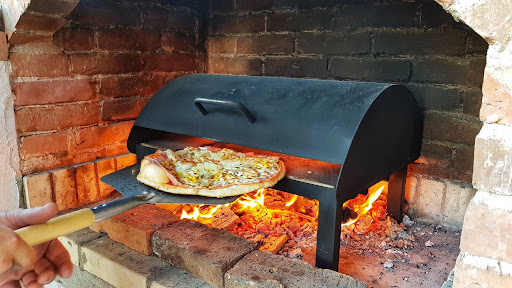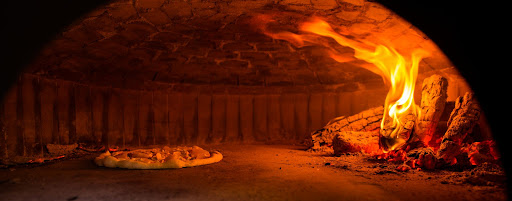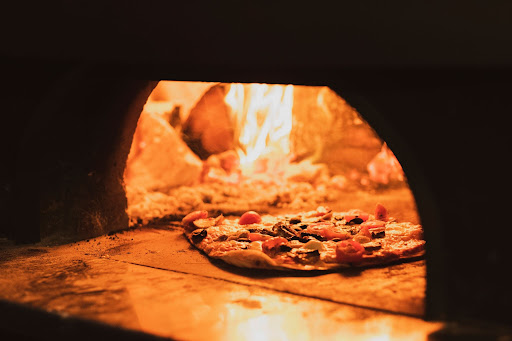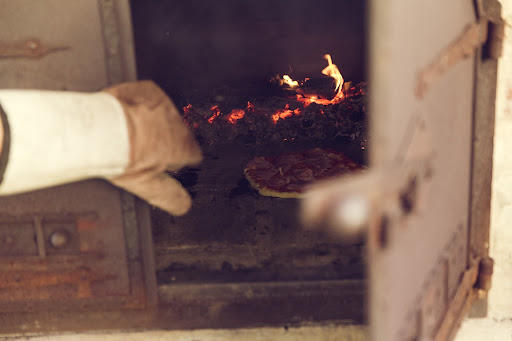Pizza ovens have become a popular addition to private gardens in the last few years. This shouldn’t be a surprise, as delicious home-made pizza is not only a great party food, but also a good way to add some novelty to your daily diet. As a plus, watching pizzas being cooked in a wood-fired oven can be surprisingly engaging entertainment. Choosing the right pizza oven might seem troublesome, but with just a few easy steps, you can figure out exactly what you want to put in your garden. So without further ado – let’s take a closer look at the things that will help you get the best pizza oven for your needs.
How do outdoor pizza ovens work?
Before you start cooking, or even begin browsing for one, it’s good to know how exactly pizza ovens work. If built correctly,a garden pizza oven allows cooking with three types of heat – conduction, radiant, and convection. Most of the time you’re going to utilize all of them at once, but you can also pick up ovens that excel in one of them.
Conduction heat is transferred between objects that are directly in contact with each other. In the case of pizza ovens, this comes from the pre-heated oven floor or pizza stone (in modern ovens).
As its name suggests, radiant heat comes from radiation – both from a direct heat-source (e.g., burning logs of wood) and heated objects (like the oven walls). There’s no direct contact between the food and heat-emitting surfaces. This is basically how a microwave cooks.
Convection cooking gets its heat from hot air circulating inside the oven’s dome. The air movement can be controlled by opening and closing the oven’s door.
Things to consider while choosing a garden pizza oven
To get the right outdoor oven, you have to take a few factors into account. Here are five most important aspects of choosing a pizza oven. You should also remember that despite having pizza in their name, these types of ovens can be used for preparing anything you can bake, roast, cook, or grill (some people even use them as a BBQ substitute).
Size, or how many pizzas you want to prepare at once
Pizza ovens come in various sizes – from tiny ones that can fit just a single pie, to giants that can get you a few dozens of pizzas in an hour. If you’re not planning on starting a commercial pizza cooking business, the latter won’t be necessary. While pondering the size of your to-be pizza oven, always consider how much cooking you plan to get out of it.
If you just want to pop up a pizza from time to time or plan on preparing just a single dish for a family dinner, a small outdoor oven that fits 1-2 regular-sized pizzas (about 25 cm in diameter dough) would be a fine choice.
For pizza aficionados and party animals that prefer cooking larger amounts of pizzas in one go, a medium-sized oven for 3-4 pizzas will work just right. It will give you bigger pizza output without sacrificing cooking quality. This is also a good option for larger families and people that need to prepare multiple dishes simultaneously.
Material, or what type of cooking you prefer
Material used greatly affects the heating time and maximal temperature an oven can reach. In general, there are two ways you can take – metal or brick ovens.
Metal pizza ovens (typically made from stainless steel or aluminium) heat way faster, allowing for quick cooking endeavours. Unfortunately, this also means a metal oven cools down quicker after you let the fire die out, so preparing anything that needs a longer cooking process (e.g., bread or roasted poultry) requires maintaining the fire for much longer periods. So this is the better option if you just want to prepare a quick bite and don’t have the patience or time for slow cooking.
A brick pizza oven needs more time to build up the heat (as bricks store it just to radiate it out, when the fire is gone), but offer high temperatures (easily over 500°C) and can hold heat for way longer. This also applies to other refractory materials. The leftover heat can be used for anything from drying vegetables, to heating meals cooked earlier, or simply keeping your tea warm. So if you don’t mind waiting longer for your food and want to prepare something more when the main cooking is done, a brick oven is what you’d need.
Fuel, or how you like your outdoor cooking experience to be
The so-called pizza purists claim that the only “real” way to make pizza is to cook it in wood-fired pizza ovens made of bricks. Although the classic pizza-cooking experience they provide is something worth trying out at least once, wood-fired ovens might not be a valid option for everyone. For example, some neighbourhoods prohibit burning – in those cases gas pizza ovens are the way to go.
Burning wood gives pizza (and other dishes) a distinctive taste and texture that can’t be 100% recreated by other means. Many people also consider this type of cooking as the healthier option. As a plus, watching the flames dance across the wood logs is an oddly entertaining and soothing experience that the whole family can enjoy. But you should keep in mind that picking the wrong type of wood can really mess up your food. Avoid conifers (especially pine wood) as they contain a lot of taste-altering resin, which also leaves large amounts of soot when burned.
Gas ovens are definitely the lower-maintenance option – you just turn them on and wait for them to heat up. They are also easier to find a suitable location to place them as they produce far less smoke and thus are easier to be accepted by strict neighbourhoods. So if you just want to make your pizza in peace and don’t need any of that overhyped classic experience of cooking pizza, this is the way to go.
Location, or where a garden pizza oven can be placed
In terms of placing your pizza oven, there are three options – free-standing, built-in or portable.
Free-standing outdoor oven is rather self-explanatory – it’s a singular construct that sits on its own foundation. This mostly includes the biggest wood-burning ovens, but you can also find smaller ones of this type.
The built-ins can be incorporated into other structures already present in the garden (e.g., stone grills, walls etc.). It’s a common type for both gas and wood ovens.
A portable pizza oven can be moved around freely throughout the garden thanks to its wheels (although it would be rather smaller than the other two types of outdoor ovens). Portable ovens are mostly gas-fueled, but you can also find wood-fired models quite easily. A small enough portable oven can even be taken on camping trips.
No matter which type you choose, there are three universal rules about placing outdoor ovens:
- Don’t place them near fuel deposits/storages.
- They shouldn’t be exposed to strong winds.
- The smoke shouldn’t go to your neighbours.
DIY vs premade oven options
Lastly, you should ask yourself this question – Do I want to build my pizza oven myself? If the answer is yes, there are two options – build it from scratch or buy a DIY kit. Both of these can bring you a lot of satisfaction, especially if you’re an avid constructor, but they can be risky – even small mistakes can result in the oven not working as it should be.
For those preferring convenient solutions, buying a fully assembled pizza oven is the way to go. These types of ovens are ready to use almost right out-of-the-box and don’t require any handyman knowledge to be set up properly. As a downside, you don’t have much say about its overall look – you get what you bought and there’s not much customization to be done.
As a sort of middle ground, you can also pick up modular oven kits. They’re way easier to assemble than DIY kits while still leaving you plenty of room for customization, so you can get both the satisfactory kick and convenience perk in one package.
The choice depends mostly on personal preferences, as the cost of all three options is very similar.
Outdoor pizza ovens – do they really live up to the hype?
Setting aside the boom in popularity in recent years and the superiority complex of some wood oven owners, pizza ovens are one of the most versatile cooking equipment you can get for your garden. They come in a wide range of options – both from the size and material standpoint. Brick ovens retain heat for longer, allowing you to use it long after you’ve prepared your perfect pizza. Metal ones (with a hot stone floor) are mostly used as commercial ovens, as they can pop one pizza after the other at an express rate, despite lower heat retention capabilities. Which are the best outdoor pizza ovens? This depends largely on your needs – some prefer a smaller oven that runs on gas, while others would rather pick up a larger oven that cooks with wood-burning. So bring your outdoor cooking to the next level and enjoy a pizza party or a family dinner with your own garden pizza oven.











